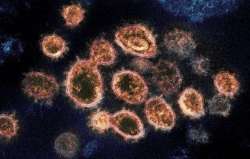Coronavirus epidemic hit East Asia 20,000 years ago: Study
The study found that the outbreak left traces in the genetic makeup of people from East Asia, an area that is now China, Japan, Mongolia, North Korea, South Korea, and Taiwan.

In a new study, researchers have discovered that a coronavirus epidemic broke out in the East Asia region more than 20,000 years ago, similar to the current Covid-19 pandemic.
The study found that the outbreak left traces in the genetic makeup of people from East Asia, an area that is now China, Japan, Mongolia, North Korea, South Korea, and Taiwan, said the researchers from the Queensland University of Technology, University of Adelaide, the University of California San Francisco, and the University of Arizona.
"The modern human genome contains evolutionary information tracing back tens of thousands of years, like studying the rings of a tree gives us insight into the conditions it experienced as it grew," said Professor Kirill Alexandrov from CSIRO-QUT Synthetic Biology Alliance.
In the last 20 years, Coronaviruses are responsible for three major outbreaks -- the SARS-CoV leading to Severe Acute Respiratory Syndrome, which originated in China in 2002 and killed more than 800 people; MERS-CoV leading to Middle East Respiratory Syndrome, which killed more than 850 people, and the current SARS-CoV-2 leading to Covid-19, which has so far killed 3.9 million people globally.
For the study, published in the journal Current Biology, the team analysed the genomes of more than 2,500 modern humans from 26 worldwide populations, to understand how humans have adapted to historical coronavirus outbreaks.
The team found the role of a specific type of protein, known as a VIP (virus-interacting protein) -- proteins that are part of the cellular machinery that interact with viruses that enter the body.A In the millions of years of human evolution, natural selection has led to the fixation of gene variants encoding virus-interacting proteins (VIPs) at three times the rate observed for other classes of genes.
In the study, researchers found signs of adaptation in 42 different human genes encoding VIPs.
"We found VIP signals in five populations from East Asia and suggest the ancestors of modern East Asians were first exposed to coronaviruses over 20,000 years ago," said said lead author Dr Yassine Souilmi, with the University of Adelaide's School of Biological Sciences.
"We found the 42 VIPs are primarily active in the lungs -- the tissue most affected by coronaviruses -- and confirmed that they interact directly with the virus underlying the current pandemic," Souilmi added.
The study helps gain an understanding of how genomes of different human populations adapted to the viruses that have been recently recognised as a significant driver of human evolution. It may also help to identify viruses that have caused epidemics in the distant past.
"This, in principle, enables us to compile a list of potentially dangerous viruses and then develop diagnostics, vaccines and drugs for the event of their return,"Alexandrov said.
(With IANS Inputs)
ALSO READ | Scientists discover Covid's link to life threatening blood clots
ALSO READ | Footprints of last dinosaurs walked 110M years ago in UK found